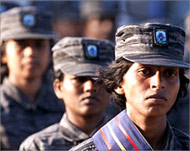New hope for Sri Lanka twenty years on
In the early 1980s many experts predicted Sri Lanka would become Asia’s number one success story.

They argued that its plentiful natural resources, educated and highly-skilled workforce, and enormous tourist-potential would make it become the new Singapore.
But when hundreds of Tamils were slaughtered in a week of carnage in the capital Colombo in 1983, the country was relegated to the international dog-house.
More than 60,000 people have since been killed in a conflict which began with the Tamil Tigers taking up arms 20 years ago.
Western arms embargo
After the July 1983 riots that left dead about 600 Tamil men, women and children, western nations imposed arms embargoes on Sri Lanka.
Following the riots, hundreds of thousands of Tamils fled to India for a safe haven.
But India burnt its fingers with a 32-month military intervention in Sri Lanka that failed to disarm the Tamil Tigers.
After losing 1,200 of their troops at the hands of Tiger guerrillas, New Delhi completed a withdrawal of its troops in 1990 and has since adopted a hands-off policy towards the island.
However, Asian diplomats said India was back in the picture, but this time focusing on trade.
“India’s involvement in Sri Lanka is low profile, but they are advising the government in several areas, including security,” a top diplomatic source said.
New hope
However, there is a new era of hope for Sri Lanka now that a ceasefire truce is in place between the Tamils, who are seeking a separate state in the north and east of the island, and the majority Singhalese.
As a result, Sri Lanka is now seen by the United States, European nations and Japan as a model to other nations grappling with internal conflicts.
“It is an important achievement for the world if Sri Lankans themselves are able to resolve their differences,” American Deputy Secretary of State Richard Armitage said as international donors pledged $4.5 billions in aid last month.
The aid package symbolised a recognition that an end to the conflict was possible with both sides expected to make painful compromises.
 |
|
The Tamil Tigers are fighting for |
International pariah
This was in sharp contrast to what happened after the 1983 riots which made Sri Lanka a pariah in the eyes of the international community.
What had remained a law-and-order problem until July 1983 became a full-blown conflict with the slaying of 13 government troops.
The killing of soldiers from the majority Singhalese community saw retaliatory attacks against minority Tamils.
However, the sanctions eased by Western nations in the early 1990s were to come back after 1996 when government forces were accused of killing more than 650 Tamils in the northern peninsula of Jaffna.
But when President Chandrika Kumaratunga announced in December 1999 that she had invited Norway to broker peace, another thaw ensued.
Prime minister Ranil Wickremesinghe then cemented his ties with Washington by meeting President George W Bush last year.
There is now unprecedented military co-operation between the two countries with Sri Lanka getting more US support to train its security forces and being able to buy hardware without any hurdles.
Tigers outlawed
Twenty years after the start of the conflict, the countries which sympathised with the Tigers have banned them.
India outlawed the Tigers in 1992 after holding the guerrillas responsible for the May 1991 slaying of its former premier Rajiv Gandhi.
And the United States and Britain are among countries which have declared the Tigers a foreign terrorist group.
However, both countries have said they were willing to reconsider, depending on the behaviour of the Tigers.
Meanwhile, the Sri Lankan army is no closer to defeating the Tigers militarily, and there is a tacit recognition that peace will only be possible at the negotiating table.